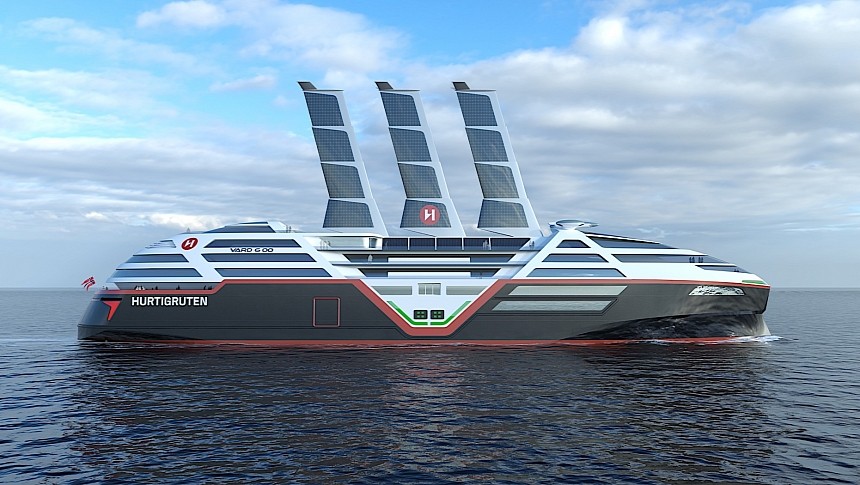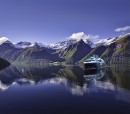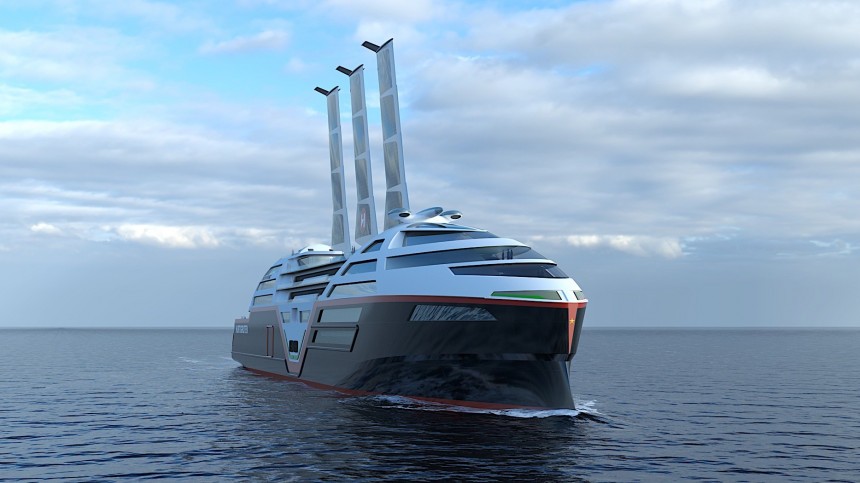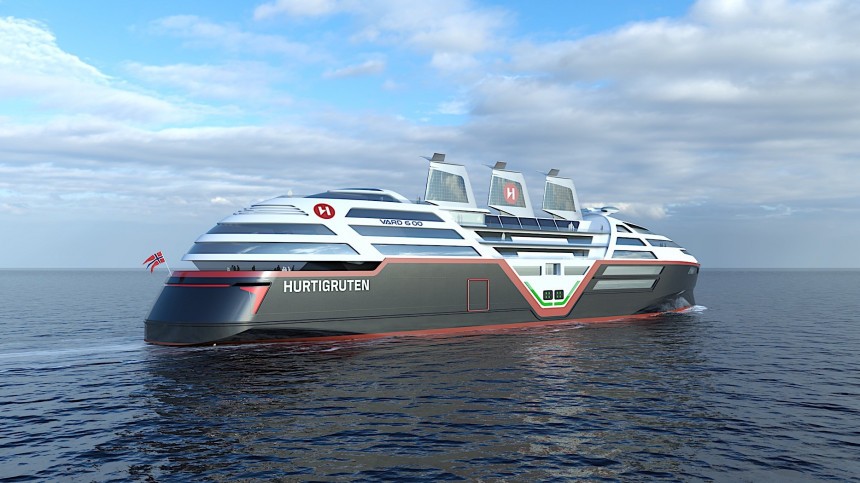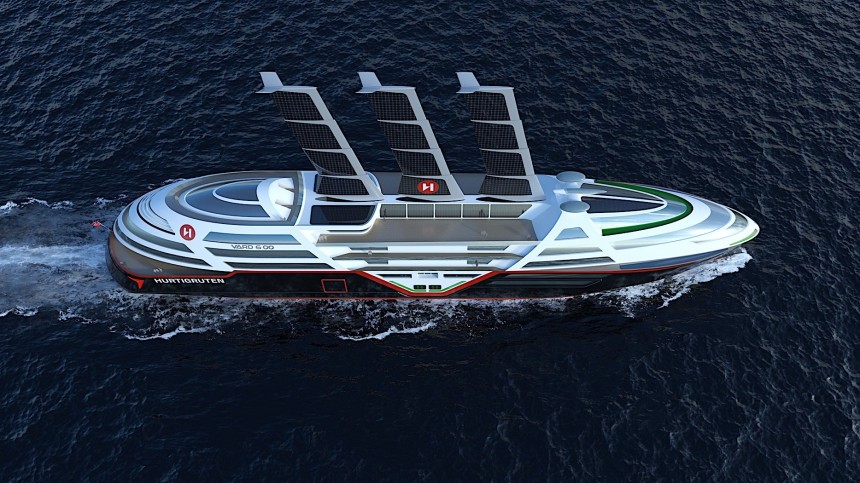For the uninitiated, or at least for those of us who don't usually take cruises, the name Hurtigruten may not mean all that much. But should the company succeed in creating the "world's most energy-efficient cruise ship", it may very well become a much more common name in everyday conversations.
Hurtigruten has been around for 130 years, having started life as a supplier of public sea transport in Norway. It grew so much that it now has a fleet of 15 ships, serving the needs of dozens of ports.
All of the above makes the company, at a local level and from an operational standpoint, a very important one. On a global scale, its impact is even greater, as it is the "world's largest expedition cruise company."
But that's probably not what the world will remember these guys for. History books will probably make a note of Hurtigruten as being one to press the accelerator pedal very hard to become green, and lead the way for others to do the same.
Just to give you an idea of what I'm talking about, just consider the fact that in 2019 the company got possession and started operating the world's s first two hybrid-powered expedition cruise ships, the Roald Amundsen and Fridtjof Nansen.
What hybrid means in this case is that both vessels use electric propulsion to sail for up to 30 minutes before making the switch to conventional means of forward motion. That may not seem all that much for the untrained eye, but given the fact this is a cruise ship we're talking about, those 30 minutes could translate into as much as a 20 percent reduction in emissions. In simpler numbers, the pair of vessels designed by Rolls-Royce could cut 6,400 metric tons of CO2 emissions, or the equivalent of what over 5,500 cars can release in the atmosphere in a year.
But it's not the above hybrid technology that is the topic of this story, but a future vessel that should be powered entirely by electricity, reducing its emissions to an absolute zero.
The ship is called Sea Zero, for now. It was first announced by Hurtigruten in March 2022, and a little over a year later we got our first glimpse at what it will be all about. And, let me tell you, it's shaping up to be an engineering marvel filled with mysteries and wonders.
Before we get into it it's worth mentioning the amount of details known so far about the project is very small, so a lot of those mysteries will remain unsolved. Yet what we do know is so incredible that if successful, it's bound to change the industry.
First, the technical sheet. The Sea Zero (or whatever name the company settles on) will be 135 meters (443 feet) long. That's significantly longer than a football pitch, and long enough to allow for no less than 270 cabins for 500 guests to be constructed. The ship will also have a cargo hold and will be capable of transporting cars (unknown how many of them).
For power the ship will not use diesel-, gas- or even liquified natural gas-burning engines, but electricity. The build will be equipped with a suite of batteries with a capacity of 60 megawatts – that's a lot, and translates into 60,000 kilowatts, or the capacity of some 850 average electric cars.
The batteries will get their fill of electricity while in port. As the coolest twist you'll see on any such seafaring machine, the batteries' charge levels will be displayed on the ship's exterior for everyone to see.
Despite their large size, the batteries are not enough to satisfy the ship's needs during long cruises. That's why they'll also be recharged at sea, thanks to a solar panel array of unthinkable dimensions.
The Sea Zero will be equipped with solar panels spanning 1,500 square meters (over 16,000 square feet). They'll be mounted on retractable wing rigs which will also hold wind sails. As with all other ships everywhere, the sails will help with forward motion, complementing the undisclosed electric motors that'll make the contra-rotating propellers spin. The sails themselves will have a surface area of 750 square meters (8,000 square feet), and when extended will climb to a height of 50 meters (164 feet).
All of the above are features that, according to the company, have never been used on a ship. So will the "multiple retractable thrusters" that have not been detailed and left us craving for more info.
Another industry first will be the use of artificial intelligence for maneuvering. It's not clear at this point what the system is and what it will have to do, exactly, but the deployment of AI should allow for a bridge that's closer to an airplane cockpit in terms of size and design than the command deck of a vessel.
The ship will not be the only one going green, and even the passengers will be asked to contribute to Sea Zero's minimal impact on the environment. How that will be accomplished is still a mystery, but we do know it will involve a smartphone app that'll guide people to minimize their energy consumption while on board.
Hurtigruten plans to have the Sea Zero above the waves in 2030, and for that it targets 2026 as the year when the build should start, at the hands of a yet unnamed shipyard. As it stands now, the team behind the project is hard at work trying to figure out battery production, propulsion technology, and hull design.
The biggest challenge at this point is finding ways to bring down the energy consumption of onboard hotel operations, which on a normal cruise ship account for about 50 percent of energy needs.
We'll keep an eye out for more information on this incredible project and update this story every time we learn something new.
All of the above makes the company, at a local level and from an operational standpoint, a very important one. On a global scale, its impact is even greater, as it is the "world's largest expedition cruise company."
But that's probably not what the world will remember these guys for. History books will probably make a note of Hurtigruten as being one to press the accelerator pedal very hard to become green, and lead the way for others to do the same.
Just to give you an idea of what I'm talking about, just consider the fact that in 2019 the company got possession and started operating the world's s first two hybrid-powered expedition cruise ships, the Roald Amundsen and Fridtjof Nansen.
What hybrid means in this case is that both vessels use electric propulsion to sail for up to 30 minutes before making the switch to conventional means of forward motion. That may not seem all that much for the untrained eye, but given the fact this is a cruise ship we're talking about, those 30 minutes could translate into as much as a 20 percent reduction in emissions. In simpler numbers, the pair of vessels designed by Rolls-Royce could cut 6,400 metric tons of CO2 emissions, or the equivalent of what over 5,500 cars can release in the atmosphere in a year.
The ship is called Sea Zero, for now. It was first announced by Hurtigruten in March 2022, and a little over a year later we got our first glimpse at what it will be all about. And, let me tell you, it's shaping up to be an engineering marvel filled with mysteries and wonders.
Before we get into it it's worth mentioning the amount of details known so far about the project is very small, so a lot of those mysteries will remain unsolved. Yet what we do know is so incredible that if successful, it's bound to change the industry.
First, the technical sheet. The Sea Zero (or whatever name the company settles on) will be 135 meters (443 feet) long. That's significantly longer than a football pitch, and long enough to allow for no less than 270 cabins for 500 guests to be constructed. The ship will also have a cargo hold and will be capable of transporting cars (unknown how many of them).
For power the ship will not use diesel-, gas- or even liquified natural gas-burning engines, but electricity. The build will be equipped with a suite of batteries with a capacity of 60 megawatts – that's a lot, and translates into 60,000 kilowatts, or the capacity of some 850 average electric cars.
Despite their large size, the batteries are not enough to satisfy the ship's needs during long cruises. That's why they'll also be recharged at sea, thanks to a solar panel array of unthinkable dimensions.
The Sea Zero will be equipped with solar panels spanning 1,500 square meters (over 16,000 square feet). They'll be mounted on retractable wing rigs which will also hold wind sails. As with all other ships everywhere, the sails will help with forward motion, complementing the undisclosed electric motors that'll make the contra-rotating propellers spin. The sails themselves will have a surface area of 750 square meters (8,000 square feet), and when extended will climb to a height of 50 meters (164 feet).
All of the above are features that, according to the company, have never been used on a ship. So will the "multiple retractable thrusters" that have not been detailed and left us craving for more info.
Another industry first will be the use of artificial intelligence for maneuvering. It's not clear at this point what the system is and what it will have to do, exactly, but the deployment of AI should allow for a bridge that's closer to an airplane cockpit in terms of size and design than the command deck of a vessel.
The ship will not be the only one going green, and even the passengers will be asked to contribute to Sea Zero's minimal impact on the environment. How that will be accomplished is still a mystery, but we do know it will involve a smartphone app that'll guide people to minimize their energy consumption while on board.
The biggest challenge at this point is finding ways to bring down the energy consumption of onboard hotel operations, which on a normal cruise ship account for about 50 percent of energy needs.
We'll keep an eye out for more information on this incredible project and update this story every time we learn something new.
